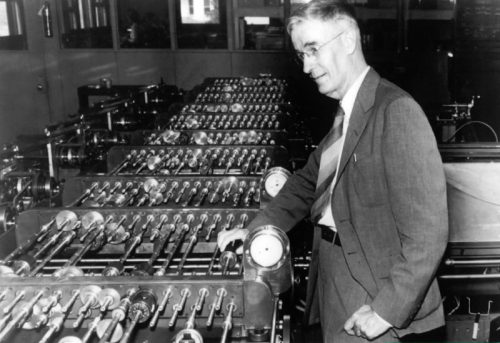
Retrotech — With a Future?
Before there were electronic digital computers, there were mechanical analog computers. Although now obsolete for practical computation, these devices might actually have an useful future ahead of them–in education.
Mechanical analog computation (analog means that calculation is done by measuring rather than by counting) goes back to the Greek Antikythera mechanism (65 BC), which was used to predict the positions of heavenly bodies. The modern era of analog computing began with the work done by James Thompson and his brother William (Lord Kelvin) in the 1870s. First, James Thompson created a mechanical device that performs the calculus function of integration.
Lord Kelvin applied this device…along with other mechanisms for addition and trigonometric functions…to create a mechanical tide-prediction system. These tide predictors had a pretty good run: the invention was announced in 1876, and some of these systems were still in use in the early 1970s!
For those who haven’t studied calculus, integration can be thought of as a kind of continuous addition. Imagine a hose with a fluctuating flow rate filling a pool: by integrating the rate of flow, you can calculate the volume of water added to the pool.
The basic concept of a mechanical integrator is shown below.

If the vertical shaft is turned at a constant rate, and the small wheel is moved in and out according to the changing value of some some variable Y, then the rotation of the horizontal shaft Z will represent the integral of Y with respect to time. If Y is the rate of flow of the a hose, Z will be the total volume added to the pool. If Y represents the acceleration of a vehicle, then the output shaft will give that vehicle’s speed at any moment. Connect the output to the input of another integrator, and you will get the distance traveled.
Vannevar Bush, who would become Roosevelt’s science adviser during WWII, combined the integrator and other computing mechanisms to create a highly general mechanical computer, called a differential analyzer. Completed in 1931, it was not restricted to a single application, but could be programmed–with a wrench and screwdriver to alter the connections–for a wide range of problems. Complex chains of calculation were possible, including the ability for a result at one stage to be fed back as input at an earlier stage–for example, the speed of a simulated vehicle affects its air resistance, which in turn influences its acceleration…which integrates back to its speed.

Other differential analyzers were built in the U.S., Norway, and Britain, and were used for applications including heat-flow analysis, electrical network stability analysis, soil-erosion studies, artillery firing table preparation, and studies of the loading and deflection of beams. It is rumored that a British analyzer was used in the planning for the bouncing-bomb attack on German hydroelectric dams during WWII. Differential analyzers appeared in several movies, including the 1951 film When Worlds Collide (video clip). The ultimate in mechanical analog computation was the Rockefeller Differential Analyzer, a rather baroque (and very expensive) machine built in 1942. It was decommissioned in 1954, on the belief that the future of calculation would belong to the electronic computer, and especially the electronic digital computer. Following the decommissioning, the mathematician Warren Weaver wrote:
It seems rather a pity not to have around such a place as MIT a really impressive Analogue computer; for there is vividness and directness of meaning of the electrical and mechanical processes involved… which can hardly fail, I would think, to have a very considerable educational value. A Digital Electronic computer is bound to be a somewhat abstract affair, in which the actual computational processes are fairly deeply submerged.
Crusade
A bit of a loaded word, isn’t it? But a label that American anti-slavery activists would have felt entirely comfortable with, in the first half of the 19th century. Such was the knowledge that taking up the cross of a cause could be hazardous, indeed but the fight was for the right, and the eventual prize was worth it and more; the promise that every man (and by implication, every woman as well) had a right to be free. Not a slave, as comfortable as that situation might be to individuals but to be free, answering only to ones’ conscience, as was expressed in the Declaration of Independence. “We hold these truths to be self-evident, that all men are created equal, that they are endowed by their Creator with certain unalienable Rights, that among these are Life, Liberty and the pursuit of Happiness…” Life, liberty and the pursuit of happiness, never mind that one might have varying degrees of success in that pursuit one had the right to decide how to go about it, in whatever method and manner than one chose. One had the right to not be property, as if an ox or a horse.
Revolution
This article from Law & Liberty reminded me of the 1989 Revolutions, the largest political and cultural events of our lifetimes. I felt pricked that I had also forgotten and de-emphasised those events in my thinking, I who have two sons born behind the Iron Curtain. Shameful, really. John-Adrian’s first memory is of angry crowds milling outside his apartment building in Oradea, shouting “Iliescu SOS!, Ceausescu JOS!” in 1989 when he was four.
One can make a case that rights for women or for black people were bigger issues over the last century, but those loom larger in North American and perhaps Western European consciousness than the rest of the world. Also, it is difficult to separate out the life-improvements for those groups from the massive improvements in opportunities and standard of living for everyone in those societies. Yes, there are infuriating stories of blacks or women of ability who could not go to college or enter certain professions in 1920, but that was true for a lot of white men as well. In Russia, people were routinely executed, starved, or sent off to the GULAG, and then decades later they just weren’t anymore, because those entire governments had collapsed.
We get caught up in anger at the issues of our day, but some are never going to amount to much. We are fighting over whether people who claim to be a different gender from their birth sex are going to be able to game the system and make us all have to go along with it. Americans are very big on individual rights even at great inconvenience to the group, and Europeans are very big on looking modern and free of tradition (especially when they can compare themselves favorably to Americans), so transgender people in either direction may succeed in having the rest of us be made to shut up and go along. As I said, it’s gaming the system, but it could work. And that will irritate many of us and have bad unforeseen consequences.
But it won’t be execution, or labor camps, or inability to choose our profession or where we live.
No, the rise and fall of communism has been the largest event of our days, but even those of us who should know that get distracted. Popular culture has distracted us away from that main point to hand-wringing about smaller items. We are letting down the succeeding generations who are not hearing about these great events as much as they should. I listen to history podcasts, but seldom hear any historians make reference to those events in Eastern Europe and Asia. The things they talk about are true, and valuable. Yet in talking about the planets, even the largest planets, they neglect to mention the sun. We need to mention the sun.
So I resolve to put in some effort in November to remind us of the rise of communism in 1917 and 1949, the executions and oppressions in mind-boggling numbers, the fall of the USSR thirty years ago and the economic reforms in China a few years after that. That latter is certainly not a fall of communism, but it was perhaps a 25% fall, and it remains to be seen if it will also prove to be unsustainable.
The Romanians have a very good national anthem, “Awake, Romanians.” We can only make ours into a rock version by doing it ironically. There is nothing ironic about this version, and you can feel their enthusiasm to your toes. It looks fun to sing. I still haven’t figured out how to embed a video, but it will be enjoyable for you to click the link. https://www.youtube.com/watch?v=tqicikxFVys
Movie Review: The Current War
This movie is focused on the interaction among Thomas Edison, George Westinghouse, and Nikola Tesla in the competition to create and build out America’s…and the world’s…electrical infrastructure. It has gotten mixed and generally not-very-enthusiastic reviews; I thought it was well-done and definitely worth seeing. Visually, it is striking and sometimes even beautiful, thus worth seeing on the big screen.
The movie gets the outline of the history right; also, I think, the essence of the characters. Edison is a brilliant inventor and self-promoter who is committed to his DC-based distribution system and will do some more-than-questionable things to get it universally adopted. Westinghouse, who had invented the railroad air brake (among other things) and already built a large company, sees the value of alternating current, which can be stepped up and down in voltage via transformers and hence can be economically transmitted over long distances. Tesla, a Serbian immigrant and brilliant inventor, provides the missing link in the form of a practical motor that can run on AC power. The relationships of Edison and Westinghouse with their respective wives are highlighted, and the future utility mogul Samuel Insull appears as Edison’s young secretary.
I was happy to see the movie’s positive portrayal of Westinghouse, a great man who has tended to be overshadowed by the more-glamorous figures of Edison and Tesla. (The legions of Tesla fans may be unhappy that Tesla did not get a more central role in the film.)
If this movie sounds interesting to you, better see it soon; I don’t think it’s going to be in the theaters for very long.